An examination of the 2020 electorate, based on validated voters
By Ruth Igielnik, Scott Keeter and Hannah Hartig
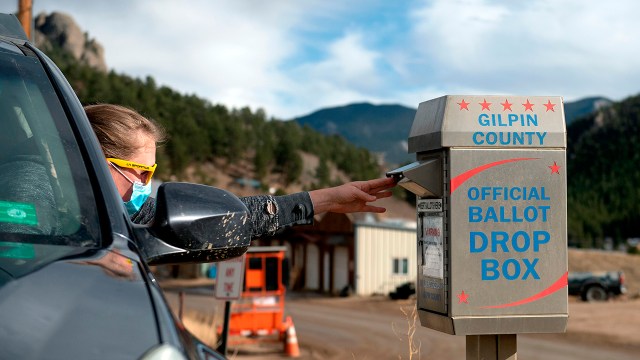
Note (July 2023): A new report about the 2022 validated voters used slightly revised 2020 estimates. There was nothing inaccurate about the 2020 results, but we chose to use a slightly different survey weighting approach that increases the precision of our estimates. None of the substantive findings from the 2020 report have been impacted. See the 2022 methodology for more detail.
Pew Research Center conducted this study to understand how Americans voted in 2020 and how their turnout and vote choices differed from 2016 and 2018. For this analysis, we surveyed U.S. adults online and verified their turnout in the three general elections using commercial voter files that aggregate official state turnout records. Panelists for whom a record of voting was located are considered validated voters; all others are presumed not to have voted.
We surveyed 11,818 U.S. adults online in November 2020, 10,640 adults in November 2018 and 4,183 adults in November and December 2016. The surveys were supplemented with measures taken from annual recruitment and profile surveys conducted in 2018 and 2020. Everyone who took part is a member of Pew Research Center’s American Trends Panel (ATP), an online survey panel recruited through national, random sampling of telephone numbers or, since 2018, residential addresses. This way nearly all U.S. adults have a chance of selection. The surveys are weighted to be representative of the U.S. adult population by gender, race, ethnicity, partisan affiliation, education, turnout and vote choice in the three elections, and many other characteristics. Read more about the ATP’s methodology.
Here are the questions used for this report and its methodology.
The 2020 presidential election was historic in many ways. Amid a global pandemic, with unprecedented changes in how Americans voted, voter turnout rose 7 percentage points over 2016, resulting in a total of 66% of U.S. adult citizens casting a ballot in the 2020 election. Joe Biden defeated Donald Trump 306-232 in the Electoral College and had a 4-point margin in the popular vote. While Biden’s popular vote differential was an improvement over Hillary Clinton’s 2016 2-point advantage, it was not as resounding as congressional Democrats’ 9-point advantage over Republicans in votes cast in the 2018 elections for the U.S. House of Representatives.
Validated voters, defined
Members of Pew Research Center’s nationally representative American Trends Panel were matched to public voting records from three national commercial voter files in an attempt to find a record for voting in the 2020 election. Validated voters are citizens who told us in a post-election survey that they voted in the 2020 general election and have a record for voting in a commercial voter file. Nonvoters are citizens who were not found to have a record of voting in any of the voter files or told us they did not vote.
A new analysis of validated 2020 voters from Pew Research Center’s American Trends Panel examines change and continuity in the electorate, both of which contributed to Biden’s victory. It looks at how new voters and voters who turned out in one or both previous elections voted in the 2020 presidential election and offers a detailed portrait of the demographic composition and vote choices of the 2020 electorate. It also provides a comparison with findings from our previous studies of the 2016 and 2018 electorates.
A number of factors determined the composition of the 2020 electorate and explain how it delivered Biden a victory. Among those who voted for Clinton and Trump in 2016, similar shares of each – about nine-in-ten – also turned out in 2020, and the vast majority remained loyal to the same party in the 2020 presidential contest. These voters formed substantial bases of support for both Biden and Trump. Overall, there were shifts in presidential candidate support among some key groups between 2016 and 2020, notably suburban voters and independents. On balance, these shifts helped Biden a little more than Trump.

Overall, one-in-four 2020 voters (25%) had not voted in 2016. About a quarter of these (6% of all 2020 voters) showed up two years later – in 2018 – to cast ballots in the highest-turnout midterm election in decades. Those who voted in 2018 but not in 2016 backed Biden over Trump in the 2020 election by about two-to-one (62% to 36%).
Both Trump and Biden were able to bring new voters into the political process in 2020. The 19% of 2020 voters who did not vote in 2016 or 2018 split roughly evenly between the two candidates (49% Biden vs. 47% Trump). However, as with voters overall, there was a substantial age divide within this group. Among those under age 30 who voted in 2020 but not in either of the two previous elections, Biden led 59% to 33%, while Trump won among new or irregular voters ages 30 and older by 55% to 42%. Younger voters also made up an outsize share of these voters: Those under age 30 made up 38% of new or irregular 2020 voters, though they represented just 15% of all 2020 voters.
One somewhat unusual aspect of the 2016 election was the relatively high share of voters (nearly 6%) who voted for one of the third-party candidates (mostly the Libertarian and Green Party nominees), a fact many observers attributed to the relative unpopularity of both major party candidates. By comparison, just 2% of voters chose a third-party candidate in 2020. Overall, third-party 2016 voters who turned out in 2020 voted 53%-36% for Biden over Trump, with 10% opting for a third-party candidate. Among the 5% of Republicans who voted third-party in 2016 and voted in 2020, a majority (70%) supported Trump in 2020, but 18% backed Biden. Among the 5% of Democrats who voted third-party in 2016 and voted in 2020, just 8% supported Trump in 2020 while 85% voted for Biden.
Here are some of the other key findings from the analysis:
- Biden made gains with suburban voters. In 2020, Biden improved upon Clinton’s vote share with suburban voters: 45% supported Clinton in 2016 vs. 54% for Biden in 2020. This shift was also seen among White voters: Trump narrowly won White suburban voters by 4 points in 2020 (51%-47%); he carried this group by 16 points in 2016 (54%-38%). At the same time, Trump grew his vote share among rural voters. In 2016, Trump won 59% of rural voters, a number that rose to 65% in 2020.
- Trump made gains among Hispanic voters. Even as Biden held on to a majority of Hispanic voters in 2020, Trump made gains among this group overall. There was a wide educational divide among Hispanic voters: Trump did substantially better with those without a college degree than college-educated Hispanic voters (41% vs. 30%).
- Apart from the small shift among Hispanic voters, Joe Biden’s electoral coalition looked much like Hillary Clinton’s, with Black, Hispanic and Asian voters and those of other races casting about four-in-ten of his votes. Black voters remained overwhelmingly loyal to the Democratic Party, voting 92%-8% for Biden.
- Biden made gains with men, while Trump improved among women, narrowing the gender gap. The gender gap in the 2020 election was narrower than it had been in 2016, both because of gains that Biden made among men and because of gains Trump made among women. In 2020, men were almost evenly divided between Trump and Biden, unlike in 2016 when Trump won men by 11 points. Trump won a slightly larger share of women’s votes in 2020 than in 2016 (44% vs. 39%), while Biden’s share among women was nearly identical to Clinton’s (55% vs. 54%).
- Biden improved over Clinton among White non-college voters. White voters without a college degree were critical to Trump’s victory in 2016, when he won the group by 64% to 28%. In 2018, Democrats were able to gain some ground with these voters, earning 36% of the White, non-college vote to Republicans’ 61%. In 2020, Biden roughly maintained Democrats’ 2018 share among the group, improving upon Clinton’s 2016 performance by receiving the votes of 33%. But Trump’s share of the vote among this group – who represented 42% of the total electorate this year – was nearly identical to his vote share in 2016 (65%).
- Biden grew his support with some religious groups while Trump held his ground. Both Trump and Biden held onto or gained with large groups within their respective religious coalitions. Trump’s strong support among White evangelical Protestants ticked up (77% in 2016, 84% in 2020) while Biden got more support among atheists and agnostics than did Clinton in 2016.
- After decades of constituting the majority of voters, Baby Boomers and members of the Silent Generation made up less than half of the electorate in 2020 (44%), falling below the 52% they constituted in both 2016 and 2018. Gen Z and Millennial voters favored Biden over Trump by margins of about 20 points, while Gen Xers and Boomers were more evenly split in their preferences. Gen Z voters, those ages 23 and younger, constituted 8% of the electorate, while Millennials and Gen Xers made up 47% of 2020 voters.1
- A record number of voters reported casting ballots by mail in 2020 – including many voters who said it was their first time doing so. Nearly half of 2020 voters (46%) said they had voted by mail or absentee, and among that group, about four-in-ten said it was their first time casting a ballot this way. Hispanic and White voters were more likely than Black voters to have cast absentee or mail ballots, while Black voters were more likely than White or Hispanic voters to have voted early in person. Urban and suburban voters were also more likely than rural voters to have voted absentee or by mail ballot.
This analysis is based on a survey of 11,818 members of Pew Research Center’s American Trends Panel conducted Nov. 12-17, 2020, shortly after the general election. It also draws on surveys conducted among 10,640 panelists from Nov. 7-16, 2018, after the midterm election that year and 4,183 panelists from Nov. 29 to Dec. 12, 2016, after the general election. Researchers attempted to match the panelists to three different commercial voter files that contain official records of voter registration and turnout for 2016, 2018 and 2020. (For more details, see Methodology.)
This study marries official turnout records with a post-election survey among a large, ongoing survey panel, with the goal of improving the accuracy of the results compared with relying on self-reported turnout alone. The survey panel also makes it possible to examine change in turnout and vote preference over time among many of the same individuals. This analysis joins a growing body of research seeking to achieve a more accurate assessment of the 2020 election, each based on somewhat different sources of data.2 Different methods and data sources have unique strengths and weaknesses, meaning that specific estimates are likely to vary among the studies and no single resource can be considered definitive.
Voting patterns in the 2020 election
The 2020 election featured continuity in the voting patterns of major demographic and political groups in the population, but there were a few important shifts. The gender gap in the 2020 election was narrower than it had been in 2016 as Democrats made gains among men and Republicans made gains among women. In the 2016 election, Donald Trump won men by 11 percentage points (52% to 41%) while Hillary Clinton won women by 15 points (54% to 39%). In the 2018 election, Democrats substantially narrowed the gap with men (50% of men voted for Democratic candidates, 48% for Republican candidates) while maintaining an 18-point lead among women. In the 2020 election, men again divided nearly evenly (50% Trump, 48% Biden), while Biden’s advantage narrowed to 11 points among women (55% to 44%).

Similarly, as Biden increased his level of support among White men in the 2020 election relative to Clinton’s in 2016, Trump gained among White women, which had the effect of further narrowing the gender gap among White voters. In 2016, Trump won White men by 30 points (62% to 32%). That gap narrowed to a 17-point margin for Trump in 2020 (57% to 40%). White women, a group sometimes categorized as swing voters and who broke nearly evenly in 2016 (47% for Trump to 45% for Clinton), favored him in 2020 (53% to 46%).
Biden received the support of 92% of Black voters, nearly the same as Clinton received in 2016 and Democratic candidates for the U.S. House received in 2018.
While Biden took a 59% majority of the Hispanic vote, Trump (with 38%) gained significantly over the level of support Republican candidates for the House received in 2018 (25%). To be sure, Hispanic voters are not a monolith; there is substantial diversity within the Hispanic electorate.
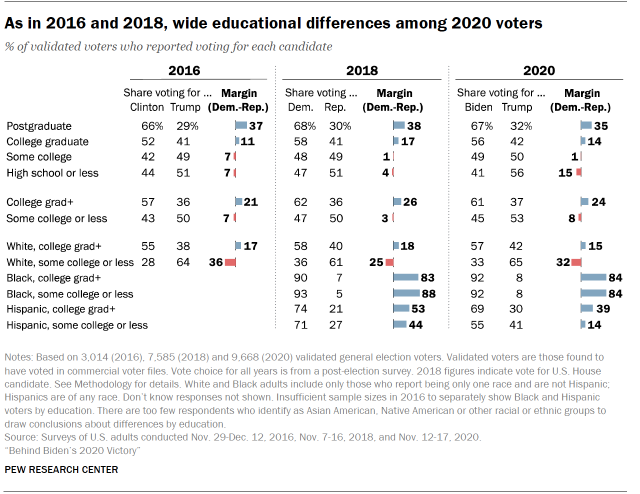
One noteworthy feature of the 2020 election was the wide education gap among Hispanic voters. In 2020, Biden won college-educated Hispanic voters 69% to 30%. At the same time, Biden’s advantage over Trump among Hispanic voters who did not have a college degree was far narrower (55% to 41%).
One of the most pivotal groups in the 2016 election was White voters without a four-year college degree, who were critical to Trump’s electoral college victory that year (nationally, he won them by a wide 36-point margin in 2016, 64% to 28%). Prior to 2016, differences in candidate preferences by education were typically much smaller than they were that year. In 2020, Trump won 65% of White non-college voters – nearly identical to his 2016 share – even as Biden outperformed Clinton among this group (33% of White non-college voters backed Biden, up from the 28% of this group Clinton won in 2016). At the same time, White voters with a college degree or higher supported Biden by roughly the same margin they had backed Clinton in 2016.
Trump’s stronghold among White men without a four-year college degree loosened somewhat in 2020. While he still won this group by a little more than two-to one (66% to Biden’s 31%), that 35 percentage point gap is notably smaller than the 50-point gap in the 2016 election, when 73% of White men without a college degree supported Trump, compared with 23% who supported Clinton. Meanwhile, White men with a four-year college degree have become increasingly supportive of Democratic candidates, breaking close to evenly in 2016 (47% for Clinton, 44% for Trump) but supporting Biden by a 10-point margin in 2020.
At the same time, Trump’s vote share among White women without a college degree grew slightly between the 2016 and 2020 presidential elections. In 2016, White, non-college women supported Trump by a margin of 56% to 33%. By 2020, Trump’s vote share rose to 64% among this group compared with 35% supporting Biden. Among white women with a college degree, support for Biden was on par with support for Clinton in 2016 (59%-40% in 2020).
Party and ideology
Biden and Trump benefited from similar levels of party loyalty in 2020, with Trump receiving 92% support among Republicans and Republican-leaning independents and Biden getting 94% among Democrats and Democratic leaners. Comparable levels of support for each candidate were seen among Democrats (95% for Biden) and Republicans (94% for Trump), not including leaners. Among independents and those who affiliated with other parties, Biden led Trump by 52%-43%.
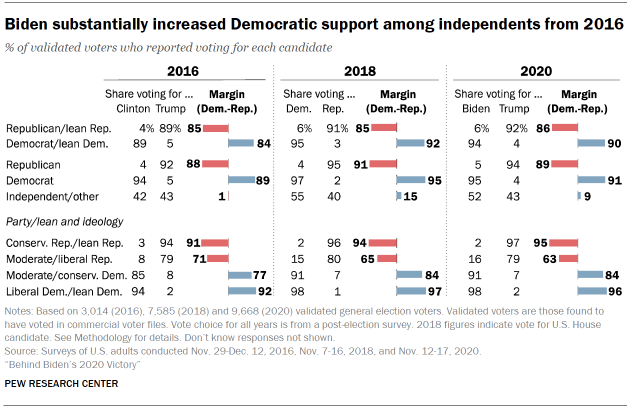
Ideological divisions within the parties were also apparent in the vote, with both Trump and Biden doing better among the ideological core of their parties. Trump received the votes of 97% of conservative Republicans and leaners but a smaller majority (79%) of Republicans who describe themselves as moderate or liberal. Biden took 98% of the vote among liberal Democrats and leaners and 91% among those who are moderate or conservative.
Age and generation
A yawning age gap in voter support – a pattern that emerged in the 2004 presidential election for the first time since 1972 – continues to be evident, with voters under 30 favoring Joe Biden by 24 percentage points (Biden 59%, Trump 35%).
Perhaps reflecting the enduring impact of this long-term age gap, voters ages 30 to 49 were also solidly in the Democratic candidate’s camp in 2020, favoring Biden by 12 points (55%-43%), similar to Clinton’s share among this age group. By contrast, older age groups divided fairly evenly between Biden and Trump, a result not too different from 2016.

These patterns also are apparent when the lens is shifted to birth cohorts, or generations – groups of voters who share birth years and perhaps formative political experiences in common, such as the popularity of the president at the time they were first eligible to vote. Voters in the youngest adult generations today – Generation Z (those ages 18 to 23 in 2020) and the Millennial generation (ages 24 to 39 in 2020) – favored Biden over Trump by a margin of 20 percentage points, though Trump gained 8 points among Millennials compared with his 2016 performance. Generation Xers, those ages 40 to 55 in 2020, divided relatively evenly (51% to 48%), as did Baby Boomers. Only among members of the Silent Generation, ages 75 to 92 in 2020, was Trump clearly favored (by 58%-42%). Notably, Boomers and Silents (and the very small number of voters from the Greatest Generation) made up less than half of the electorate in 2020 (44%), compared with just over half in both 2016 and 2018.
Geography
The political split between America’s rural areas and its suburban and urban locales remained substantial in 2020. Biden did considerably better among suburban voters in 2020 than Clinton did in 2016 (54% for Biden, 45% for Clinton). By contrast, Trump garnered the support of 65% of rural voters, including 71% of White rural voters; the latter represented an increase over the 62% he received among this group in 2016. Biden received a solid majority of votes among urban residents (66% overall), but Trump gained among urbanites relative to his performance in 2016 (33% in 2020, 24% in 2016).
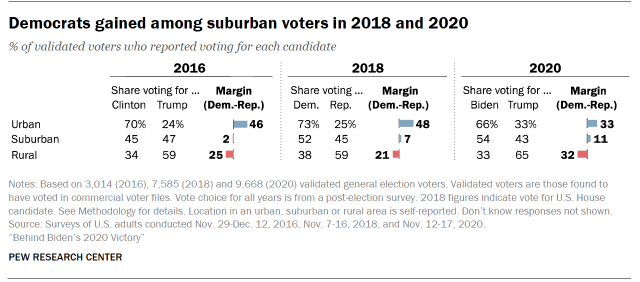
Religion
Voters in 2020 sorted along religious lines in ways consistent with recent elections. Protestants constituted nearly half of all voters (46%), as they did in 2016. Within the Protestant tradition, White evangelicals accounted for 19% of all voters, but a much higher share of Trump’s voters (34%). Without such broad support for Trump among White evangelicals, Biden would have beaten him by more than 20 points.
White non-evangelical Protestants voted for Trump over Biden by a 14-point margin (57%-43%), while Black Protestants were an overwhelmingly Democratic group (91% voted for Biden).
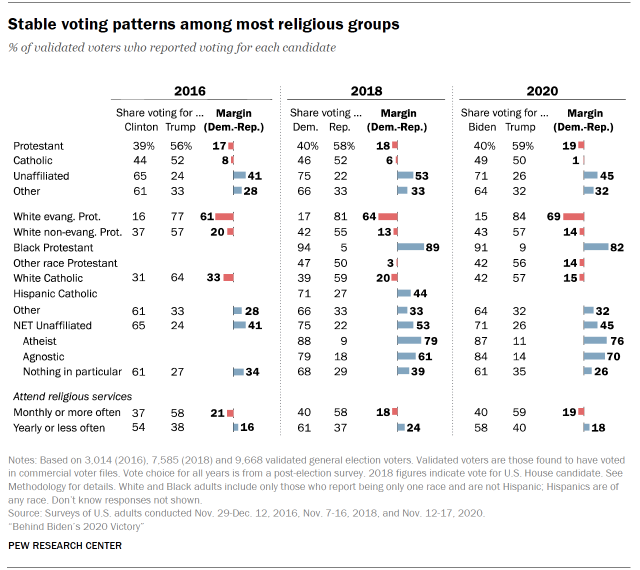
Biden, by contrast, drew strong support from religiously unaffiliated voters – atheists, agnostics, and those who say their religion is “nothing in particular.” Together, these voters made up 25% of voters, which is a slightly larger share of the total electorate than White evangelicals (19%). But support for Biden among the unaffiliated was not quite as lopsided as Trump’s support among White evangelicals (a 45-point margin for Biden among the unaffiliated vs. a 69-point margin for Trump among White evangelicals). Without the religiously unaffiliated, Trump would have had a 9-point popular vote margin over Biden.
White non-Hispanic Catholics were more supportive of Biden (at 42%) than they had been of Clinton in 2016 (31%), but Trump still captured a solid majority of their votes (57%). White Catholics made up 14% of all voters.
Demographic profiles of Trump and Biden voters
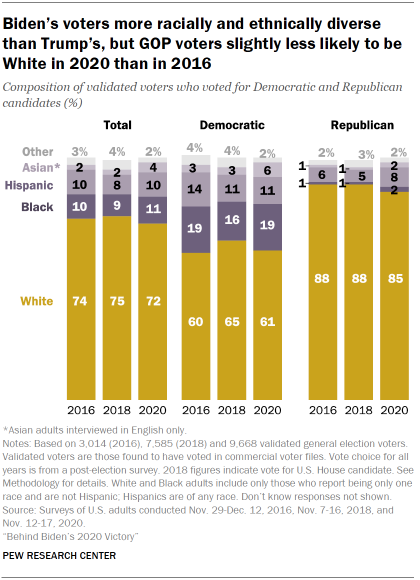
As was the case in the 2016 and 2018 elections, the Democratic voting coalition in 2020 looked quite different from the Republican coalition in several respects. Overall, Biden voters were younger, more racially and ethnically diverse, and less likely to live in rural areas than Trump voters.
In 2020, 85% of voters who cast a ballot for Trump were White non-Hispanic; this compares with just 61% of Biden voters. These differences are roughly consistent with the share of White voters in each party’s coalition in 2016.
Nearly two-in-ten voters who cast a ballot for Biden in the 2020 election (19%) were Black, identical to the share of Clinton voters in 2016 who were Black. That is significantly higher than the share of Trump voters who were Black (2%).
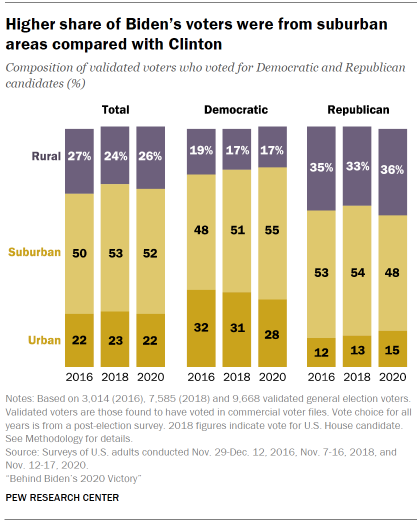
The community profiles of Trump and Biden voters are similar in some fundamental ways to the previous two elections – but more voters who cast ballots for Biden in 2020 say they live in a suburban area compared with Clinton’s 2016 voters.
Overall, urban voters continue to constitute a larger share of the Democratic coalition compared with the Republican coalition. And rural voters remain a significantly larger portion of the Republican electorate.
However, when comparing Clinton’s voters with Biden’s, there are some significant shifts. In 2016, about half of Clinton’s voters described their communities as suburban (48%), while 32% said they were from an urban area and 19% were from a rural area.
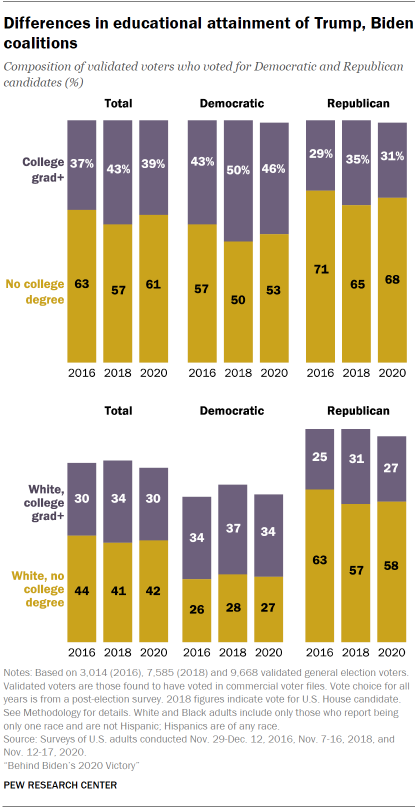
In 2020, suburban voters made up a majority of Biden’s coalition (55%); 28% of his voters said they lived in urban areas and 17% were from rural areas.
In 2020, 31% of Trump voters had at least a four-year college degree – similar to the share of Trump voters who had a college degree in 2016. Far more Trump voters (roughly 70% in each presidential election) did not have a four-year college degree.
The Democratic electorate is more evenly divided when it comes to education. In 2020, 46% of Biden voters had at least a college degree; 53% did not have a degree.
As was the case in 2016, White voters without a four-year college degree made up a considerably larger share of GOP voters (58%) than Democratic voters (27%). At the same time, White voters with a college degree made up a larger share of Biden voters (34%) than Trump voters (27%).
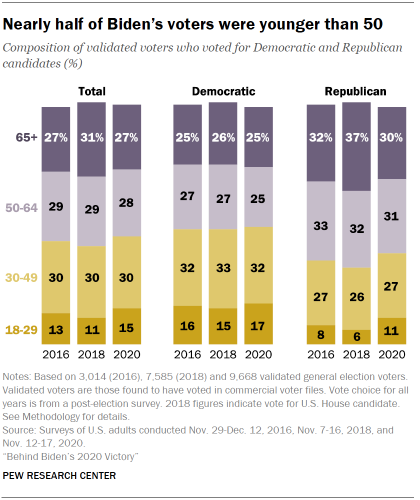
In 2020, the age profiles of Democratic and Republican voters looked largely similar to 2016. Younger adults continue to make up a larger share of Democratic voters compared with Republican voters. For example, in 2020, nearly half of Biden voters (49%) were younger than 50; that compares with 39% of Trump voters in 2020.
Protestants made up a majority of those voting Republican in 2020, just as they did in 2016. Overall, 58% of Trump voters were Protestant, compared with just 35% of Biden voters. White evangelical Protestants, in particular, remained a critical part of the Republican voting coalition, making up 34% of Trump’s voters but just 6% of Biden’s.
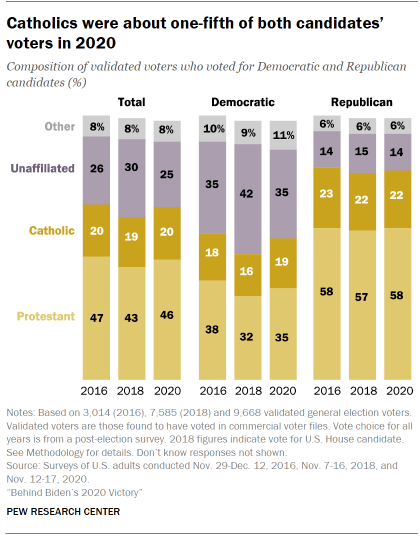
Catholics made up similar shares of Biden and Trump voters (19% and 22%, respectively); in 2016, Catholics made up a slightly higher share of Trump voters compared with Clinton voters (23% vs. 18%). Voters who were unaffiliated with any religious tradition (atheists, agnostics and those who describe themselves as “nothing in particular”) made up 35% of Biden voters but just 14% of Trump voters in 2020.
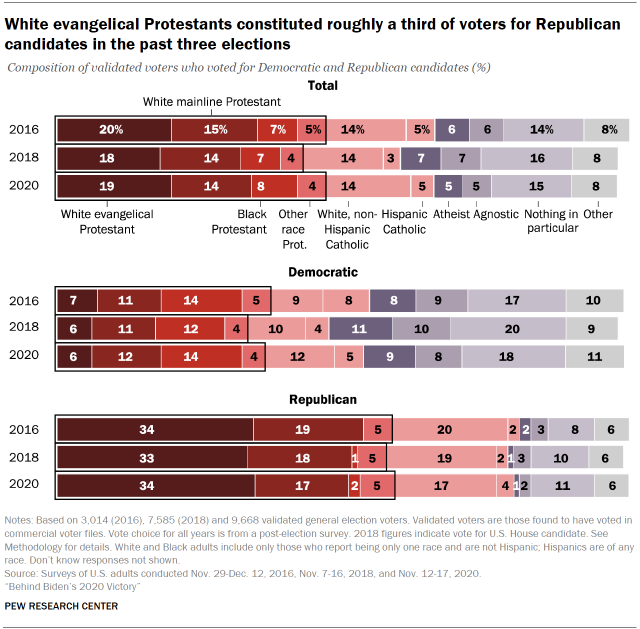
Voting methods in the 2020 presidential election
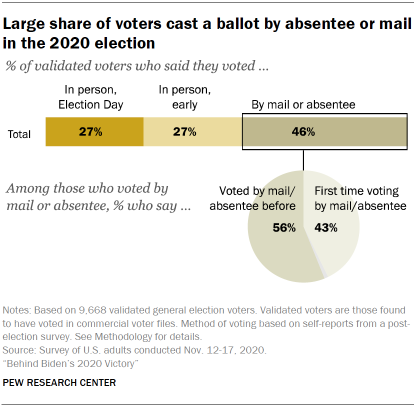
The 2020 election brought a huge change in howAmericans cast their ballots. As some states looked to adapt to challenges in administering elections amid the COVID-19 pandemic, large numbers of voters were offered expanded access to absentee and vote-by-mail options in the 2020 election. As a result, a record number of voters said they cast their ballots this way (46%). And smaller shares of voters said they either voted in person on Election Day (27%) or in person before Election Day (27%).
A majority of absentee voters said they had previously voted this way before the 2020 election (56%). Still, a sizable share (43%) said the November election was the first time they had cast an absentee or mail ballot.
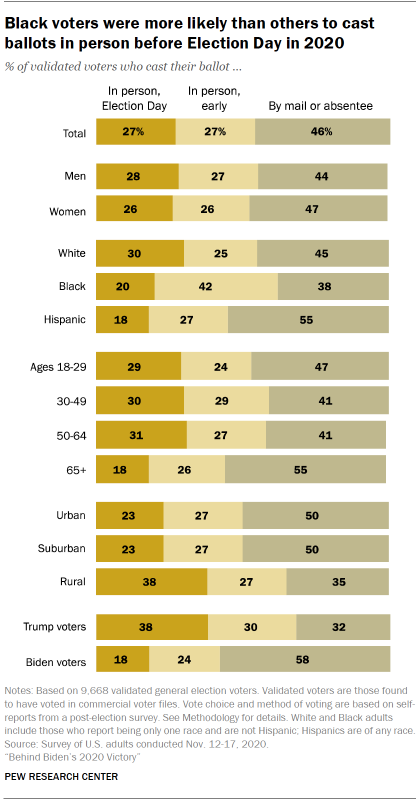
Sizable shares of voters across racial and ethnic subgroups cast absentee or mail-in ballots in the 2020 election – though there are some differences in voting methods when comparing across groups. White voters were most likely to say they voted in person on Election Day (30%). Comparably smaller shares of Black (20%) and Hispanic voters (18%) said the same.
Black voters were more likely than White or Hispanic voters to say they cast their ballot in person before Election Day (42% of Black voters, vs. 27% of Hispanic voters and 25% of White voters).
Voters ages 65 and older stand out in their voting behavior: 55% say they voted absentee or by mail in the 2020 election – 13 percentage points higher than the share of adults under 65 who cast a ballot by mail.
Urban and suburban voters were considerably more likely than rural voters to say they cast their ballot by mail (50% of urban and suburban vs. 35% of rural voters). In contrast, rural voters were more likely to report voting in person on Election Day.
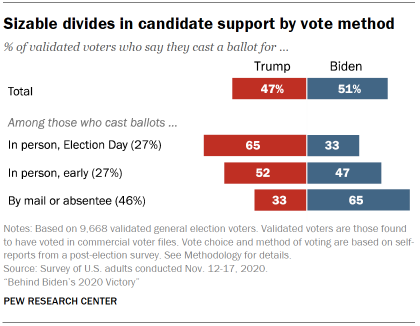
A majority of Biden voters said they voted absentee or by mail in the 2020 election (58%). By contrast, about a third of Trump voters (32%) voted by mail. Roughly two-thirds of Trump voters (68%) said they voted in person, either on (38%) or before (30%) Election Day. Reflecting these differences, Trump performed much better among voters who cast their ballots in person on Election Day (65% for Trump vs. 33% for Biden). These shares were reversed among absentee and mail-in voters: 65% of absentee voters said they voted for Biden, compared with 33% who voted for Trump.
Preferences were more evenly divided among those who cast their ballots in person ahead of Election Day: 52% voted for Trump while 47% voted for Biden.
Voters and nonvoters
The 2020 general election featured the highest rate of voter turnout in more than a century, with 66% of eligible adults casting a ballot for president.
All members of the American Trends Panel who took the 2020 post-election survey – whether they voted or not – were asked which candidate they preferred in the race for president. Nonvoters – citizens for whom no record of turnout could be located or who told us they did not vote – preferred Joe Biden over Donald Trump by 15 percentage points, 50% to 35%, compared with Biden’s 4-point overall advantage among voters.
Voters were nearly evenly divided on party affiliation, with 50% identifying or leaning Democratic and 48% identifying or leaning Republican, similar to the 51%-48% split in 2016. Nonvoters in 2020 were more closely divided on partisanship than they were in 2016. Among nonvoters in 2020, 46% were Democrats or leaned Democratic, while 41% were Republicans or leaned Republican. A majority of nonvoters in 2016 (55%) were Democrats or Democratic leaners, compared with about four-in-ten (41%) who were Republicans or leaned toward the Republican Party.
Despite notable changes in the demographics of the two candidates’ coalitions, the demographic composition of the electorate as a whole in 2020 did not differ much from that of 2016.
Although turnout was strong, stark demographic differences between voters and nonvoters similar to those seen in past U.S. elections were present in 2020, a pattern familiar to political observers.
Voters as a group were considerably older than nonvoters. Adults younger than 50 made up 45% of all voters but 68% of nonvoters – nearly identical to the pattern seen in 2016.
But generational change in the electorate was quite apparent. Very few members of Gen Z (born 1997 and later) were eligible to vote in the 2016 electorate, and they made up just 1% of all voters that year. In 2020, they were 8% of the total, though their lower rate of turnout compared with older age cohorts is reflected in the fact that they were 15% of eligible nonvoters. At the other end of the generational spectrum, members of the Silent and Greatest generations (born 1945 and earlier) fell from 16% of all voters in 2016 to just 8% in 2020, but their turnout rates remained among the highest of all generations.
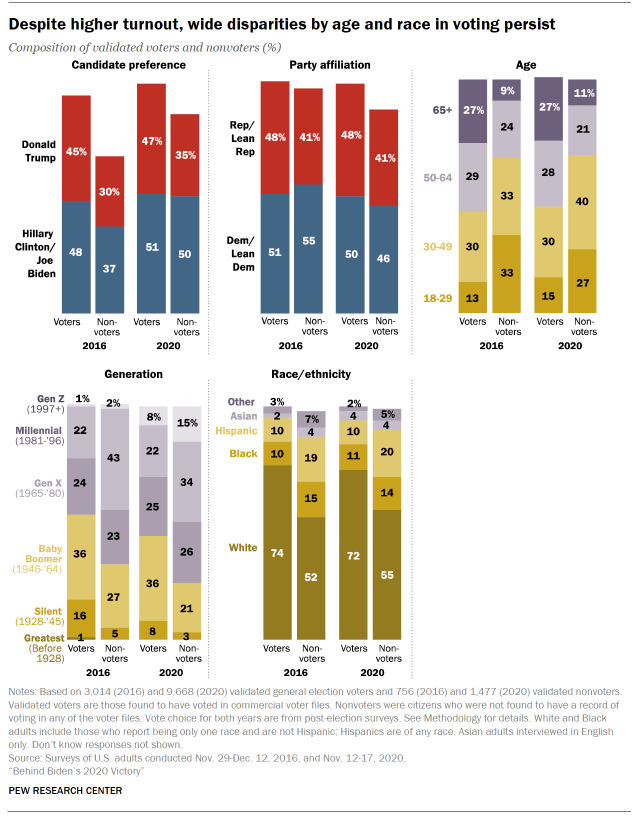
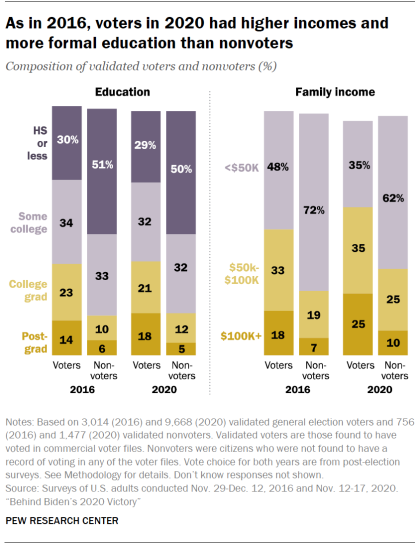
Turnout differences by race and ethnicity persisted as well. White non-Hispanic adults were 72% of voters in 2020 but just 55% of nonvoting citizens. Black Americans made up 11% of voters, but a slightly larger share (14%) of nonvoting citizens, and Hispanic adults were 10% of voters but 20% of nonvoting citizens. Asian Americans (a relatively small but fast-growing group in the U.S.) made up 4% of voters and an identical share of nonvoting citizens (note: nonvoters in this analysis do not include noncitizens).
Some of the largest differences between voters and nonvoters are seen on education and income. College graduates made up 39% of all voters in 2020 (about the same as in 2016) but only 17% of nonvoters. Adults with a high school education or less were 29% of all voters but half of nonvoters.


